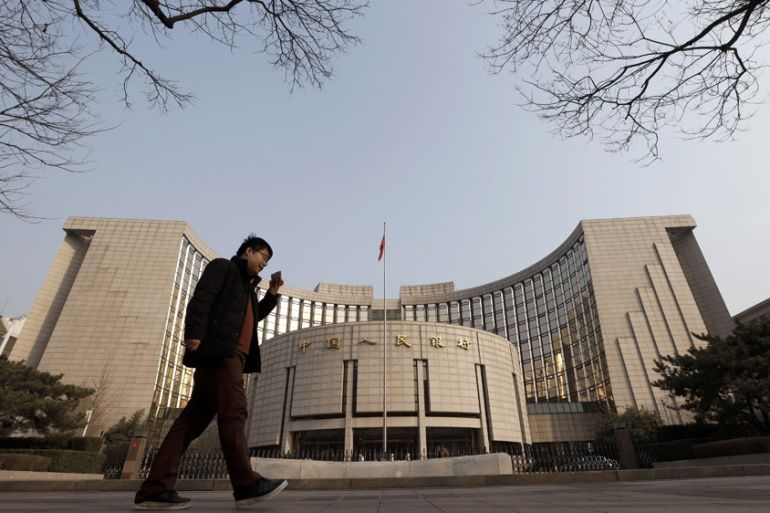China’s bank loans surge as government tries to buffer economy
China’s central bank lowers its benchmark lending rate to help businesses experiencing higher costs due to coronavirus.

New bank loans in China rose more than expected to a record high in January, as authorities step up support for an economy hit by trade tensions and facing a new threat from a fast-spreading coronavirus outbreak.
Chinese banks tend to front-load loans at the beginning of the year to get higher-quality customers and win market share.
Keep reading
list of 3 itemsVirus freezes hiring across Singapore, Hong Kong’s finance firms
EU trade chief warns coronovirus may delay China trade accord
Banks extended a record 3.34 trillion yuan ($476.42bn) in new yuan-denominated loans in January, up from 1.14 trillion yuan ($162.46bn) in December and exceeding analyst expectations, according to data released by the People’s Bank of China (PBOC) on Thursday.
Analysts polled by Reuters had predicted new yuan loans would rise to three trillion yuan ($427.39bn) in January, compared with the prior record 3.23 trillion ($460.32bn) yuan a year earlier.
Household loans, mostly mortgages, fell to 634.1 billion yuan ($90.37bn) in January from 645.9 billion yuan ($90.05bn) in December, while corporate loans rocketed to 2.86 trillion yuan ($40.76bn) from 424.4 billion yuan ($60.48bn), according to Reuters calculations based on central bank data.
Chinese regulators have been trying to boost bank lending and lower financing costs for more than a year, especially for smaller and private companies which generate a sizeable share of the country’s economic growth and jobs.
Growth in the world’s second-biggest economy slowed to 6.1 percent in 2019, the weakest pace since 1990, as demand at home and abroad slowed in part due to the US-China trade war.
On Thursday, the PBOC cut its benchmark lending rate – the loan prime rate (LPR) – as the authorities move to lower financing costs for businesses and support an economy hit by the coronavirus epidemic.
More policy steps expected
Policy sources have told Reuters the government plans to roll out more support measures as the coronavirus epidemic, which has killed more than 2,100 people and infected more than 74,000, is expected to have a devastating effect on first-quarter growth.
Annual growth of outstanding total social financing (TSF), a broad measure of credit and liquidity in the economy, stood at 10.7 percent in January, unchanged from December.
TSF includes off-balance sheet forms of financing that exist outside the conventional bank lending system, such as initial public offerings, loans from trust companies and bond sales.
In January, TSF jumped to 5.07 trillion yuan from 2.103 trillion yuan ($300bn) in December. Analysts polled by Reuters had expected January TSF of 4.3 trillion yuan ($612.56bn).
Over the past two years, Beijing has been relying on a mix of monetary and fiscal measures to weather the downturn, cutting taxes and issuing local government bonds to fund infrastructure projects while trying to spur lending, especially for small firms.
The PBOC has cut its reserve requirement ratios (RRR) – the proportion of a commercial bank’s deposits it must maintain with the central bank – eight times since early 2018, with the latest reduction taking effect on January 6. A smaller RRR would theoretically allow commercial banks to lend more money to people and companies.
A sharp drop in corporate sales and cash flow caused by the outbreak is likely to put more stress on China‘s financial system, particularly small, rural banks. The results of a stress test carried out by the PBOC last year showed that more than 13 percent of lenders were considered “high risk”.
Some relief could come from the trade front after Beijing and Washington signed a Phase 1 deal last month to defuse a protracted tariff war.